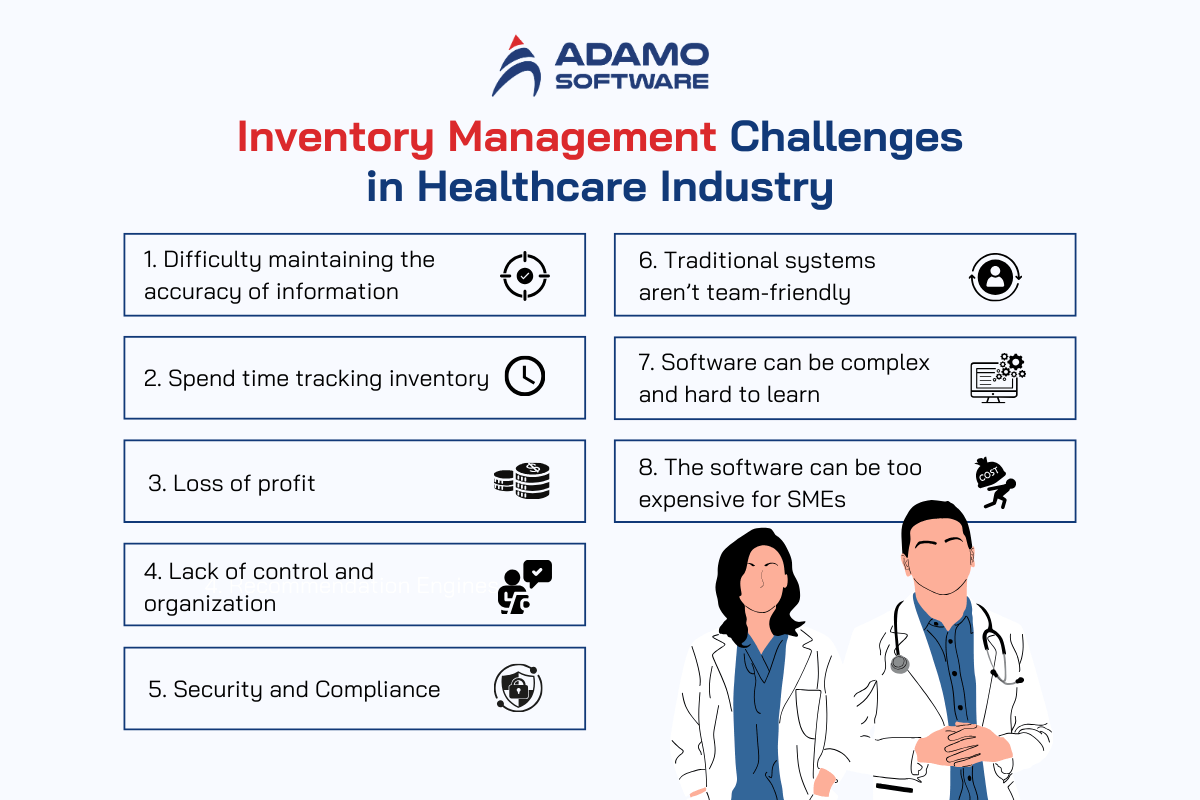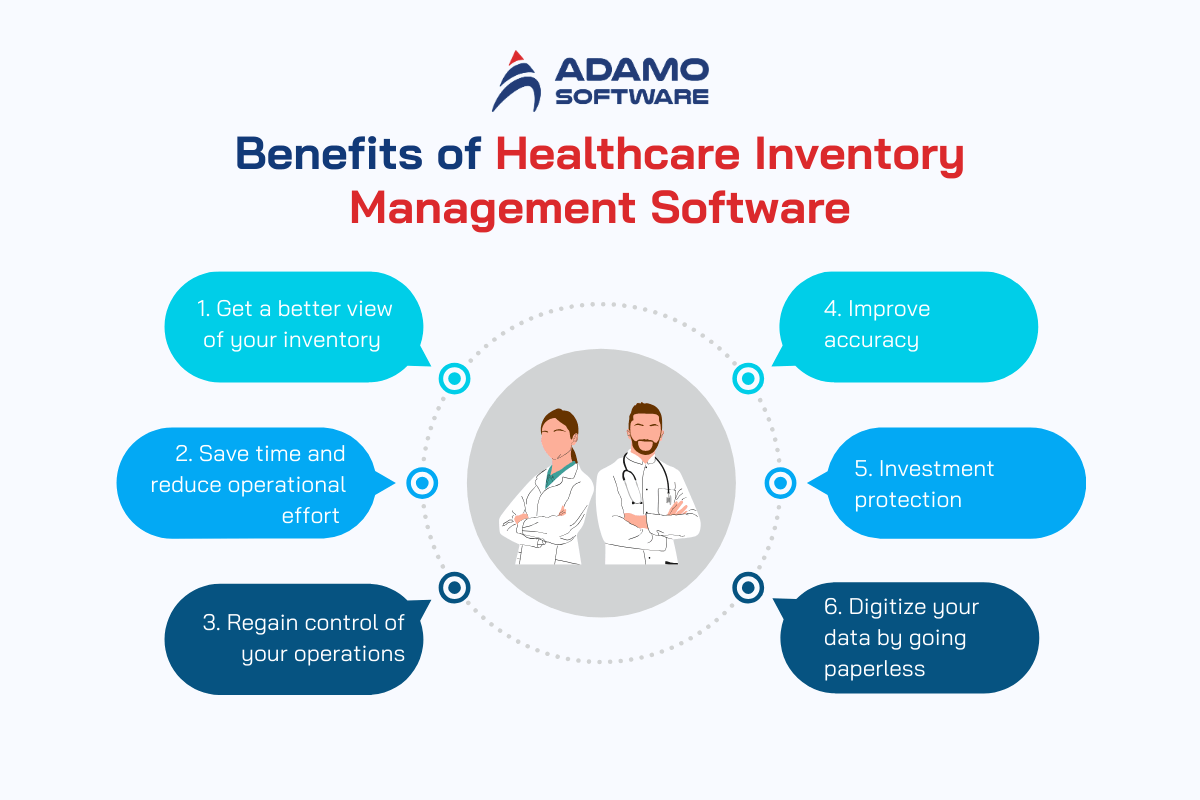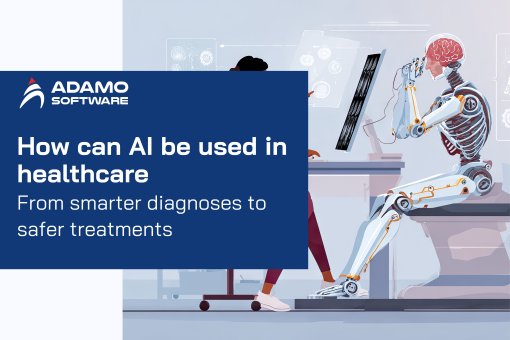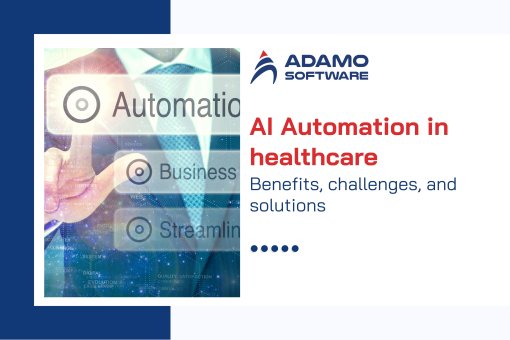How to Develop a Custom Healthcare Inventory Management Software

The healthcare industry requires a meticulous approach to managing medical supplies and equipment because inaccuracies can lead to serious problems. However, if you’ve ever had to manage hospital inventory, you know how difficult it can be. Traditional methods implemented to manage medical inventory often led to errors. So, how can we improve this process?
If you are facing the above problems, it is time to start developing healthcare inventory management software and join the digital transformation alliance. This blog will guide you through all the necessary information about developing healthcare inventory management software for your business. So, without further delay, let’s dive into the details!
I. Inventory Management Challenges in Healthcare Industry
Before getting into the information needed to build a healthcare inventory management software. We will look at some of the major challenges that companies in the healthcare industry are facing in inventory management:

1. Difficulty maintaining the accuracy of information
One of the greatest challenges in traditional inventory management is maintaining information accuracy. In the medical field, inventory management involves many moving parts. Manually tracking inventory, expiration dates, and maintenance schedules in spreadsheets or on paper can lead to mistakes. This can not only be detrimental to medical facilities but also affect patients. Therefore, medical companies’ inventories must always be accurate and updated regularly.
2. Spend time tracking inventory
Medical professionals and staff usually spend a lot of time focusing on patient care instead of managing the inventory of medical equipment and supplies. When managing inventory, scrolling through unorganized spreadsheets consumes precious time. This is time that doctors or nurses could spend with patients.
3. Loss of profit
Although the primary goal of the healthcare industry is to provide the best possible patient care, it is still a business. Some problems such as expired drugs, lack of medical equipment, and broken machinery lead to money loss. When inventory isn’t properly tagged and tracked, you won’t know expiration and maintenance dates and will have difficulty tracking equipment. Furthermore, these oversights can also result in ordering new supplies and equipment that they don’t need, causing financial loss to your medical company.
4. Lack of control and organization
Without healthcare inventory management software, organizing medical inventory information is extremely difficult. Sorting pages of information and constantly updating spreadsheets or paper lists make it hard to track of your medical supplies. As well as know how much expensive equipment you have, and stay aware of which supplies are available. Often, care providers and administrators feel a lack of control over their inventory, which not only costs a lot of time and money but also causes unnecessary stress.
5. Security and Compliance
Healthcare is a highly regulated industry. Many healthcare professionals have access to controlled substances. The law requires reporting any lost or misplaced substances. Care providers, clinics, hospitals, and pharmacies must report these losses. Without inventory management software, tracking can be difficult. Businesses face unsafely issues due to theft. They also face liability if law enforcement requests records.
6. Traditional systems aren’t team-friendly
Any company in the healthcare industry will tell you that teamwork is vital to providing the best patient care. It’s no surprise that this also translated into a medical company’s inventory management system. Traditional inventory tracking systems are typically only visible to one person, don’t work on mobile devices, and can’t connect to cloud data. This makes it difficult for staff and care providers to keep information synchronized. For healthcare inventory management software to be more effective, employees must be able to access the system on multiple devices. This allows the team to monitor information at all times, always know where they can find equipment or supplies, and make changes when necessary.
7. Software can be complex and hard to learn
When adopting healthcare inventory management software, it is important to consider how easily staff can learn the system. Without user-friendly software, employees may struggle to use the system consistently. Because consistent use is key to maintaining accurate inventory information, some healthcare companies are reluctant to invest in an inventory management system that their employees find difficult to navigate or can’t use.
8. The software can be too expensive for mid-sized and small companies
Some healthcare inventory management software has advanced features that small and medium-sized healthcare companies don’t need. In particular, those features often come with additional costs. Therefore, healthcare companies should implement inventory management software that fits their current budget and adapts to their evolving needs.
You can explore more about Hospital Management Systems: Types, Key Features & Must-Know Insights here.
II. Benefits of Healthcare Inventory Management Software
If your business is facing the challenges discussed above, here is good news for you. Now you can easily overcome the challenges of traditional inventory management by adopting healthcare inventory management software.
Here are the key benefits of healthcare inventory management software for companies in the healthcare industry:

1. Get a better view of your inventory
When you tag medical supplies with healthcare inventory management. You can see photos of those supplies. The software shows important information like the quantity in stock. It also shows what equipment needs to be ordered. You can see notes on the storage temperature for medications.
Healthcare inventory management software allows you to determine where equipment is stored, its condition at all times, who currently has the equipment, and when it was last used or serviced. By using this inventory management software, you will have a clear overview of your warehouse and ensure all management tasks are carried out smoothly. For example, you’ll never have to worry about running out of critical medical supplies, expired medications, or delays in inpatient care due to medical equipment shortages or malfunctions.
2. Save time and reduce operational effort
By applying healthcare inventory management software to track supplies and equipment, employees will save a lot of time on tasks related to inventory management. Instead of having to manually review spreadsheets or paperwork to figure out how many items you have in stock and when to order more, automated healthcare inventory management software does this for you. Therefore, after scanning inventory into the software, you can know exactly how much of each supply you have on hand and will receive re-order notifications when they run out. At the same time, you will also know exactly where it is stored without wasting time rummaging around in the warehouse looking for it.
3. Regain control of your operations
Using healthcare inventory management software to inventory medical supplies and equipment allows you to focus more on your business. All staff can pay attention to more important things, such as patient needs, by minimizing the mental and physical limitations that traditional inventory methods place on patients.Additionally, because multiple employees have access to inventory data, they will always know what supplies are in stock and where important equipment is kept.
4. Improve accuracy
When healthcare inventory management softwares is applied, inventory accuracy will greatly increase compared to using spreadsheets or paperwork, which can cause many problems. Not only does it reduce the chance of human error, but having a secure cloud-based system connected to a mobile app will help you receive updated inventory information in real-time. For example, when supplies are replenished or devices are inspected, all users have access to the system so they can see changes immediately. This goes a long way in helping doctors, nurses, and administrators avoid confusion or incorrect information when updating inventory.
5. Investment protection
For any healthcare company, having to replace lost or misplaced instruments or equipment is extremely costly. As healthcare inventory management systems allow you to track where equipment is and who is responsible for it, you can protect your investment in medical equipment and supplies allowing you to provide the best patient care.
6. Digitize your data by going paperless
Healthcare inventory management software not only helps you keep inventory information more organized but also helps you save on printing and paperwork costs. Taking action to protect the environment while improving accuracy, optimizing workflow, and providing more time for patient care is a true win-win.
III. Features You Must Have in Your Healthcare Inventory Management System
Building custom medical device management software requires a comprehensive understanding of the necessary features tailored to your requirements.

1. Multi-user access on many different devices
Your healthcare inventory management software must be accessible on all devices, from laptops and tablets to Android and iPhone. This way, relevant staff can easily monitor inventory anytime, anywhere. Cloud-based applications provide the flexibility and responsiveness to make this happen.
Your medical supplies management solution must also be accessible to both the care and administrative teams. This results in a streamlined process that improves efficiency. Anyone who needs to check supply availability can do a quick search on their device, no more time-consuming emails, texts, or calls.
2. Track medical inventory usage
Have you ever encountered the problem of lack of inventory? With so many employees using so many different supplies, keeping track can be difficult.
Healthcare inventory management software that allows you to see who inspected the supplies and what they used them for. This will help you better manage not only your inventory but also your employees.
3. Warning about dwindling inventory
Depleting vital health care supplies could spell disaster. Acting as a reorder management system, your inventory tracking should have low-stock alerts to automatically send reminders when supplies begin to run low. This ensures you will be able to replenish inventory as soon as needed. Make sure these alerts can be set to trigger notifications in the app, email, or both.
4. Real-time healthcare inventory tracking across multiple locations
Your healthcare inventory management software should be able to tell you within seconds the type and quantity of supplies you have, their location, their shape, and how to replenish them. This will help you avoid wasting time searching for necessary items. In a hospital setting, this can mean the difference between life and death.
An efficient system will also help you avoid ordering too many supplies. With a few clicks, you can get clear information about the items that need replenishment. You can also track the inventory of shipments and slow-moving items. It makes purchasing, sourcing, and supplier management much more efficient.
More importantly, the inventory tracker allows for expiration date management. This will then allow employees to rotate inventory, so older products will be used first. You can avoid throwing away expired supplies.
5. User-friendly interface
When building healthcare inventory management software, ensure even the least tech-savvy staff can easily use it. You will save time training employees. The intuitive and intuitive user interface will do the trick. The system must be designed simply so that anyone can use it easily on the first try – no complicated instructions are required.
6. Scan the QR code or barcode
Your healthcare inventory management software should have a built-in scanner that allows you to quickly lookup codes and inventory information. This will help you reduce manpower costs and errors. Your system must be able to work with your product’s existing QR labels and barcodes. It should also allow you to create your code.
An effective healthcare inventory management software allows you to easily get more information about an item by scanning it with your mobile device. You can also check the item, update its details, add notes, and change its location.
7. Control user access and permissions
Security is the most important thing. Not everything in your system is accessible to all of your employees. Effective healthcare inventory management software allows you to control employee operations, view information, and edit details. While your team needs enough time to do their work effectively, a thorough review is still important. The software must allow you to effectively control medical inventory and check the use of supplies and equipment.
8. Ability to export and import data
The right healthcare inventory management software for hospitals makes your job significantly easier across all functions. Select a system that enables bulk data import and export. This way, you can easily prepare audit checklists, order sheets, training manuals, and reports to share with employees, investors, and customers.
IV. How Inventory Management Software Works
Healthcare inventory management software works by automating critical inventory management tasks including the process of receiving, storing, and distributing medical supplies and equipment. Most healthcare inventory management software will come with a monthly subscription and a one-time implementation fee. Therefore, it provides a return on investment to users by reducing labor costs and expenses related to inventory carrying.
Here’s an example of how Rosewood Hospital’s healthcare inventory management software works:
| Medicines | Medical supplies | Reporting |
| Set up an automated process for replenishing critical medical assets such as medicines, disposable assets, etc. to avoid a shortage of assets when needed. At the same time, receive detailed information about each drug.
|
Count cycles and monitor availability and inventory levels of medical supplies.
|
Access inventory variance reports, as well as receive notifications on supplies expiration dates to track actual usage of medical supplies.
|
V. How to Build Your Own Healthcare Inventory Management Software
Building and developing healthcare inventory management software is essential in the modern healthcare industry landscape. Here’s 10 step to build this section effectively:
1. Review and evaluate inventory management processes within a healthcare organization and provide improvement solutions.
2. Understand the needs of medical staff and warehouse managers and determine the requirements of the medical organization.
3. Identify the types of assets that require RFID tagging and design features to track medications, manage supplies, monitor inventory levels, and other requirements.
4. Create a healthcare inventory management software development plan, including implementation steps, milestones, and expected KPIs.
5. Design the user interface (UI) and user experience (UX) to suit the needs of medical staff.
6. Develop and test software in stages, implementing security features such as user identity management and role-based access for purchasing and inventory data.
7. Integrate healthcare inventory management software with other healthcare software systems (such as EHR and procurement software).
8. Install RFID readers at medical facilities and attach RFID tags to assets that need to be tracked.
9. Test user acceptance and organize training sessions for both medical and administrative staff.
10. Launch healthcare inventory management software and provide support and regular maintenance.
VI. How Much Does It Cost to Build a Custom Healthcare Inventory Management System
The average cost of using healthcare inventory management software in the healthcare industry is approximately $175 per month per user.
Besides, there is also a customer support cost, about 80 USD per month for this service package.
There are also initial setup costs, which range from $789 per customer. For more complex setups or custom software, third-party integration consulting fees can be much higher, typically falling between $10,000 and $40,000 when you work with reputable software integrators.
These are detailed costs to build custom healthcare inventory management software:
1. Average licensing costs of inventory management software
Software as a Service (SaaS) providers often price user licenses with different subscription plans, such as monthly subscriptions, annual subscriptions, or one-time fees. There are also fees for additional features beyond the basic functionality, and onboarding and training may be charged in addition to the user license fee.
Here are the average license fees per user for over 70 inventory management brands on the market:
_ Average monthly cost: $175
_ Average annual cost: $2,768
_ Average one-time cost: $1,098
Implementation & onboarding costs for inventory management software
According to one technology consulting service, the process of implementing healthcare inventory management software can take about 12 to 16 weeks.
Typically, fees for this phase of implementation will vary greatly depending on whether you need the services of an external partner for implementation or with support from the vendor itself.
– Supplier participation: For many companies, especially small companies or start-ups, cooperating with suppliers will save a lot of costs.
– Third-party engagement: If your business is large or has been in business for a long time, you may benefit from the services of a third-party implementation partner. This is also a good choice if you are deploying multiple interconnected systems at the same time. The cost of the third partner ranges from about 85 USD/hour or more. In particular, reputable businesses charge from 10,000 USD to 40,000 USD for a deployment period of 12–16 weeks (about 3 and a half months).
2. Support costs for healthcare inventory management software
Support costs are typically not included in the basic package of an healthcare inventory management software. Services such as customer support, technical assistance, data storage, and future upgrade costs may be charged separately.
These costs also vary by provider, making it difficult to determine an average. While support costs are included in the base licensing fee, an upgrade is required to access features that suit your needs.
3. Cost of additional software
Modern healthcare inventory management software includes many business-critical functions. But it is only specialized software and will not cover everything.
Small and medium-sized businesses often purchase healthcare inventory management software alongside other SaaS packages to help them meet most of their business requirements using a cloud-based system.
So, when you choose an healthcare inventory management software, you should consider what other platforms or functions you’ll be using with it, and how it affects your overall costs.
For instance:
_ Financial and accounting software
_ Customer relationship management (CRM)
_ E-commerce
_ HR
VII. Adamo – A Reliable Partner Helping You Create Healthcare Inventory Management System
As a leading healthcare software development company in Vietnam, Adamo Software is proud to be a trusted partner in creating inventory management systems in the healthcare industry. With extensive expertise in mobile application development, Adamo uses cutting-edge technologies to provide robust and cost-effective solution healthcare inventory management software.

Additionally, Adamo’s proficiency in native, cross-platform, and hybrid app development allows them to tailor solutions that meet the specific needs of the healthcare industry, enhancing inventory tracking, data security, and overall operational efficiency for your business. At the same time, ensuring a seamless development process and continuous support. Besides, we also provide healthcare solutions like Remote Patient Monitoring, Telehealth or Telemedicine, Wearable Devices to meet specific requirements from you.











